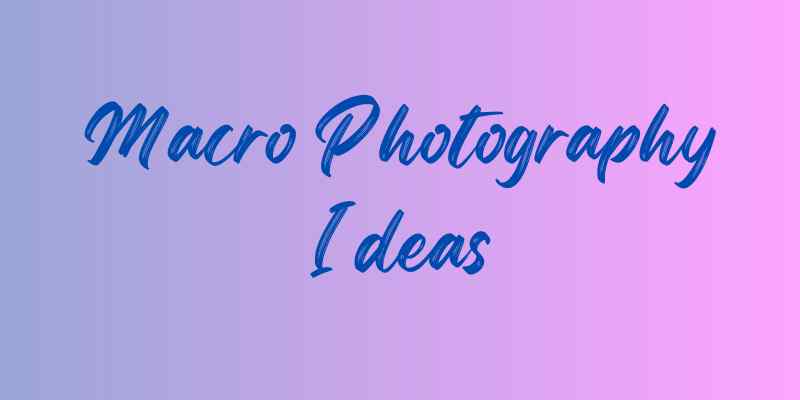Macro photography has the power to unveil an entire world that often goes unnoticed by the naked eye. Capturing intricate details and textures of small subjects can be a truly rewarding and creative endeavor for photographers. In this article, we’ll delve into a variety of captivating macro photography ideas that will inspire you to explore the fascinating miniature universe all around us.
Macro photography allows us to venture into a world that’s often overlooked. By magnifying subjects to larger-than-life proportions, we’re able to capture intricate details that aren’t immediately visible to the naked eye.
Are You Looking for a Minot Photographer in North Dakota?

Essential Equipment for Macro Photography:
This section discusses the necessary tools and gear required for successful macro photography. It might cover topics like the importance of a dedicated macro lens, the benefits of using a tripod, and the role of a remote shutter release to prevent camera shake.
Choosing the Right Subjects:
This section will guide you on how to choose appropriate subjects for macro photography. It will discuss the importance of textures, patterns, and details in the subjects, and offer suggestions for discovering captivating and visually pleasing subjects.
Mastering Lighting and Composition:
Here, you would explore the impact of lighting and composition on macro photography. This might include discussions on using diffused lighting to reduce harsh shadows and tips for arranging the elements within the frame for a balanced composition.
Exploring Unique Perspectives:
This section encourages photographers to experiment with different angles and viewpoints. It could provide examples of how shooting from uncommon perspectives can result in compelling and captivating macro photographs.
Capturing Water Droplets and Reflections:
This topic delves into the beauty of water droplets and reflections in macro photography. It might offer techniques for capturing dewdrops on various surfaces and utilizing reflections to add depth and interest to the images.
Insect Macro Photography:
This segment is all about photographing insects up close. It could discuss the challenges of approaching insects, the use of patience, and the importance of capturing the intricate details and vibrant colors of these tiny creatures.
Floral Close-Ups:
Here, the focus is on capturing the delicate details of flowers. This could cover tips for achieving sharp focus on various parts of the flower, such as the petals, pistils, and stamens, to create visually stunning floral portraits.
Textured Surfaces and Patterns:
This topic explores the art of finding textures and patterns in everyday objects. It might discuss how even mundane surfaces like fabrics, wood, or food can become visually engaging abstract subjects when magnified in macro.
Macro Abstracts:
This section delves into the world of abstract photography through macro lenses. It could discuss how focusing on small portions of larger objects can lead to intriguing shapes and forms that evoke curiosity and imagination.
Food and Beverage Close-Ups:
This topic highlights how macro photography can transform food and beverages into enticing subjects. It could discuss techniques for capturing textures, colors, and details that evoke sensory experiences, making viewers crave the subjects.
Creative Use of Colors:
Here, you would discuss the role of colors in macro photography. This might cover the impact of vibrant colors when magnified, tips for using contrasting and complementary colors, and how color combinations can enhance visual impact.
Time-Lapse Macro Photography:
This section explores the combination of macro and time-lapse photography. It might discuss the process of capturing gradual changes in small subjects over time, such as the blooming of a flower or the movement of clouds.
Extreme Close-Ups:
This topic pushes the boundaries of macro photography by zooming in even closer. It could discuss capturing minuscule details that are often invisible to the naked eye, revealing intricate textures and features.
Conclusion:
This concluding section summarizes the key takeaways from the article. It could reiterate the value of exploring the world of macro photography, emphasizing creativity, attention to detail, and the joy of discovering hidden beauty in the smallest of things.
Frequently Asked Questions
What is the best camera for macro photography?
The best camera for macro photography is one with interchangeable lenses, allowing you to attach a dedicated macro lens for optimal results.
How do I achieve a shallow depth of field in macro photography?
Achieving a shallow depth of field in macro photography requires using a wide aperture (low f-stop number) to blur the background and emphasize the subject.
What lighting setup is ideal for insect macro photography?
Soft natural lighting or diffused artificial light is ideal for insect macro photography. Harsh light can create unwanted shadows and highlights.
Can I do macro photography without a macro lens?
While a macro lens provides the best results, you can also experiment with extension tubes or close-up filters to achieve macro-like effects with a regular lens.
How do I prevent camera shake in macro photography?
To prevent camera shake, use a sturdy tripod, a remote shutter release, and a timer delay to ensure a steady shot, especially in low light conditions.


